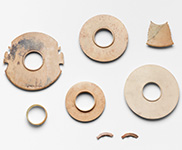Dr. Arthur M. Sackler
Individual
1913-1987
American
Relations
Child: Denise Marika, Dr. Carol Master, Arthur F. Sackler, Dr. Elizabeth A. Sackler
Former Relationship: Mrs. Else Sackler, Dr. Marietta Lutze Sackler
See Also: Arthur M. Sackler Foundation, Arthur M. Sackler Gallery, Arthur M. Sackler Gallery, Beijing, Arthur M. Sackler Gallery, Harvard University, National Museum of Asian Art, The Arthur M. Sackler Collections Trust
Source: Desmond Gure
Place of birth: New York, New York, United States
Place of activity: New York, New York, United States;
Place of death: New York, New York, United States
A lifelong New Yorker, Arthur M. Sackler was born in Brooklyn, the eldest of four sons whose parents had emigrated from eastern Europe. As a youth, he studied art by visiting museums and taking classes in sculpture with Chaim Gross, drawing at Cooper Union, and art history at New York University. He accepted jobs in advertising and editing to support himself through medical school at NYU.
After graduating in 1937, Sackler turned his focus to psychiatry, neuroendocrinology, and experimental medicine. (His research into the metabolic basis of schizophrenia was, he felt, his most significant contribution to science.) He established the Laboratories for Therapeutic Research in 1938, which he directed until 1983, and founded the weekly newspaper Medical Tribune in 1960. Through medical advertising, medical trade publications, and manufacturing over-the-counter drugs, Sackler made a fortune that he generously shared with art and scientific institutions around the world.
Sackler's philanthropy benefited several scientific institutions, such as the Sackler School of Medicine at Tel Aviv University in Israel; the Sackler Institute of Graduate Biomedical Science at NYU; the Arthur M. Sackler Science Center at Clark University in Worcester, Massachusetts; the Sackler School of Graduate Biomedical Sciences and the Arthur M. Sackler Center for Health Communications at Tufts University in Boston, Massachusetts.
His reach as a collector and donor of Asian art extended from forming the Arthur M. Sackler Foundation in 1965 to establishing museums that bear his name at Harvard University and Peking University in Beijing. He funded the creation of gallery spaces at the Princeton University Art Museum and the Metropolitan Museum of Art, where the Sackler Wing houses the ancient Egyptian Temple of Dendur. Sackler's legacy culminated with the construction and establishment of the Arthur M. Sackler Gallery, a part of the Smithsonian Institution in Washington, D.C.
A connoisseur and avid collector, Sackler acquired the world's most comprehensive collection of Chinese ritual bronze vessels. His vast holdings encompassed not only Chinese ceramics, jade, paintings, and sculpture, but also South Eastern sculpture, American and European paintings and graphics, pre-Columbian objects and textiles, Italian majolica, and Persian ceramics and silver objects. He once described his approach to collecting art, "When some people are frustrated, they go out and buy a new hat or a tie. When I have, I have gone out and bathed myself in something truly beautiful. So my collections are in a sense the measure of my frustrations." He later stated: "I collect as a biologist. To really understand a civilization, a society, you must have a large enough corpus of data."
The Communist Revolution in 1949 and its stranglehold on mainland China allowed Sackler to acquire previously privately owned treasures as they became available. At the same time, C. F. Yau and C. T. Loo, major dealers who had long dominated the New York market for Asian art, were retiring and encouraged Sackler to make purchases. He patronized other collectors and dealers in the 1950s and 1960s, including Paul Singer, Alice Boney, Howard Hollis, and Tonying and Company. Two great influences on Sackler's collecting were Frank Caro and J. T. Lai, both of whom had strong connections with C. T. Loo. Many of the objects in Sackler's collection had established provenances in North America before he acquired them.
In addition to transferring legal title of a thousand Asian art objects from his collections to the Smithsonian, Sackler contributed funds to build an art museum that connected to the Freer Gallery of Art. Keeping his collection of Asian art together was important to him. "A collection must be more than a simple accumulation of objects; it has to have a point of view, and I think it's wise for us to preserve the lifework of highly sensitive, truly dedicated collectors. In that sense, I regard myself more as a curator than a collector."
Literature
Grace Glueck, "An Art Collector Sows Largesse and Controversy," New York Times (June 5, 1983).
Arthur M. Sackler and Joy Hurwitz, One Man and Medicine: Selected Weekly Columns from the International Publishers of Medical Tribune (1972--1983) (New York, 1983).
Lon Tuck, "Convictions of the Collector: Arthur Sackler, Bringing His Oriental Treasure to Washington," Washington Post (September 21, 1986).
Grace Glueck, "Dr. Arthur Sackler Dies at 73; Philanthropist and Art Patron," New York Times (May 27, 1987).
Thomas Lawton, Asian Art in the Arthur M. Sackler Gallery: The Inaugural Gift (Washington, DC, 1987).
Warren I. Cohen, East Asian Art and American Culture: A Study in International Relations (New York, 1992).
Thomas Lawton and Thomas W. Lentz, Beyond the Legacy: Anniversary Acquisitions for the Freer Gallery of Art and the Arthur M. Sackler Gallery (Washington, DC, 1998).
Ideals of Beauty: Asian and American Art in the Freer and Sackler Galleries (London and New York, 2010).
Search http://siarchives.si.edu/search/sia_search_collections/arthur%20m%20sackler and Arthur M. Sackler Foundation website: http://arthurmsacklerfdn.org/the-sackler-collection/

